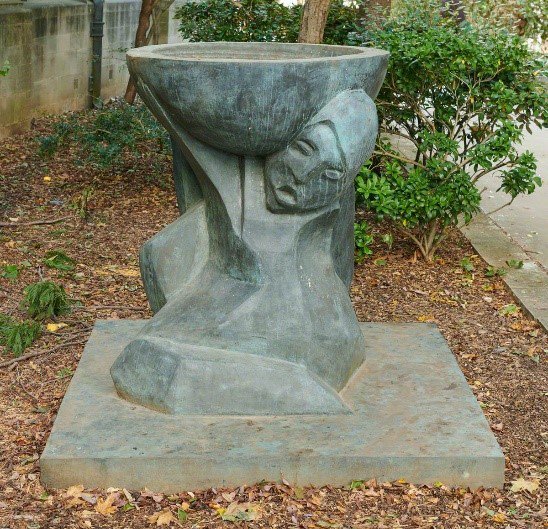2. Bird Bath, by Henri Gaudier-Brzeska
 Henri Gaudier-Brzeska, Bird Bath, designed in 1914, cast in 1992 by the Morris Singer Art Foundry Ltd. Donated to the college in 2013 by Richard Simon (Modern History, 1951).
Henri Gaudier-Brzeska, Bird Bath, designed in 1914, cast in 1992 by the Morris Singer Art Foundry Ltd. Donated to the college in 2013 by Richard Simon (Modern History, 1951).
Henri Gaudier-Brzeska was killed in action in the First World War a year after this garden sculpture was designed. This work, which spans the twentieth-century in its coming-into-being, is reminiscent of immediate predecessors such as Auguste Rodin’s Fallen Caryatid (1881) and Edvard Munch’s The Scream (1893). It also speaks to Gaudier-Brzeska’s immersion in the early twentieth-century fascination with the ‘primitive’, and with a simplified aesthetic that used shape, angle and line to accentuate emotion. He was a member of the ‘Vorticist’ group, whose work embraced the modernity of this aesthetic.
Despite its peaceful purpose, the figures holding up the bird bath are crushed and agonized by forces beyond the mere weight of the physical object they bear. One figure is defiant, silently screaming with an alarmingly direct yet empty gaze; the other’s features are distorted and twisted by her burden, one eye hardly seeing, the other staring in terror.
This dramatic piece, sitting below the quiet of the water bowl, pits the Apollonian against the Dionysian, chaos against order, angst against serenity.

Dr Je nnifer Johnson, Junior Research Fellow in History of Art
nnifer Johnson, Junior Research Fellow in History of Art
Find out more about Dr Johnson's art historical research at St John's here.